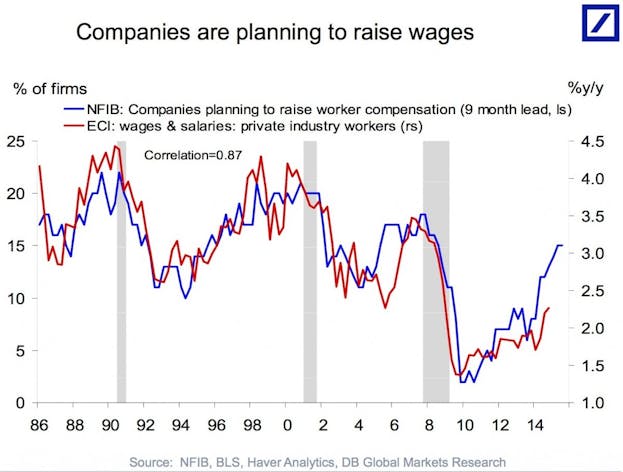McDonald’s announced Wednesday that it is raising wages for around 90,000 workers in restaurants across the country and adding additional benefits like paid vacation. It’s yet another clear sign that the job market is strengthening and employers are struggling to attract quality workers.
The move, which was first reported by the Wall Street Journal, will increase wages by $1 per hour more than the local minimum wage. The average hourly wage for McDonald's workers in the U.S. is $9.01. As a result of this wage increase, the average will rise to $9.90 by July 1 and above $10 by the end of 2016. The Journal also reports that after one year of employment, employees can earn up to five days of paid vacation. (McDonald’s move doesn't apply to franchisees, which make up nearly 90 percent of the company's restaurants, though this move might convince some franchisees to follow suit.)
McDonald's is part of a growing trend in big business. Wal-Mart made news earlier this year when it announced it would raise its wages for 500,000 workers to more than $10 per hour next year. TJ Maxx, Ikea, Target and Aetna have all raised their wages in the past few months. All of these companies are not buckling under societal pressure to boost pay. They’re doing so for economic reasons. And surveys of employers bear this out as well:

McDonald’s has long sought to hold down wages to keep its costs low, refusing to heed protesters' demands that the fast food restaurant raise wages to as high as $15 per hour. Wednesday’s announcement, of course, does not fulfill that demand. But it was always going to be difficult for the “Fight for $15” movement to convince McDonald’s to raise wages in a weak economy where labor was plentiful. Workers had little leverage to demand a boost in pay. But Monday’s move shows that the economics are finally moving in the protesters’ favor. The labor market is beginning to tighten up and McDonald’s needs to offer higher wages and better benefits to retain its current workers and attract qualified new ones.
There is one area, however, that has yet to show a hike in wages: the monthly jobs report. Except for a blip in January, wages have barely moved. In February, wages grew just 0.1 percent and have grown 2.0 percent over the past year. That 2.0 percent increase was an improvement over the past few years, especially when you factor in inflation. Inflation has declined over the past nine months as gas prices have plummeted, leading to an increase in real wages. But that's still not good enough. The Labor Department will release the March jobs report on Friday.
Even if wage growth doesn’t appear in the latest jobs report, it’s coming soon. These big-business wage hikes will force more employers to raise their own wages, otherwise they'll have trouble competing with the likes of McDonald’s and Wal-Mart for workers. And that's why the Federal Reserve should be extremely cautious in deciding when to raise interest rates above zero: That could cause businesses costs and mortgage rates to rise, slowing economic growth and preventing millions of workers from receiving wage hikes. Likewise, Congress must avoid doing anything that might hurt the economy, like allowing the sequester’s cuts in the 2016 budget to take effect. (Republicans will likely agree to undo most of those cuts.)
It’s time to feel optimistic about the labor market. Millions of workers are on the precipice of a substantial increase in their living standards. Wage increases will only beget further wage increases as those workers spend their money at different businesses and pressure builds on employers to raise their wages. Of course, a year or two of 3-4 percent wage growth does not make up for decades of near-stagnant wages. But it's more than most workers have had in a long time.
